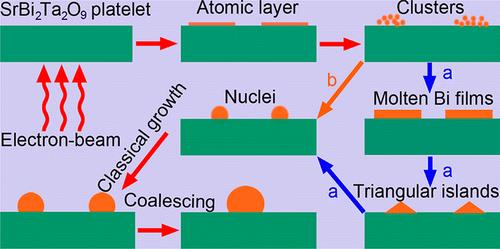
In recent years, the nucleation and growth dynamics of a nanostructure are still unclear due to the lack of experimental evidence. It is important to study the growth mechanisms of nanostructures for chemistry and materials science, which may guide the creation of new materials with novel and interesting properties. With increasing scientific interests in droplets, little is known about the behavior of interfacial nanodroplets from the early nucleation stage to the liquid dynamics.
Researchers at Xinjiang Technical Institute of Physics & Chemistry (XTIPC) of Chinese Academy of Sciences cooperated with Prof. ZANG Ling from University of Utah, directly observed the detailed growth pathways of Bi nanodroplets from the earliest stage of nucleation which were previously inaccessible.
Researchers prepared SrBi2Ta2O9 (SBT) platelet by a molten salt route and used it as substrate for Bi nanoparticle growth based on the previous work. The experiment selected nanostructures anchored to the edge of the SBT platelet to ensure observation of the growth trajectories of the Bi nanostructures clear. They observed critical nuclei for the nanodroplets formed via adding atoms to the prenucleated clusters. The process achieved through indirect transformation of an intermediate liquid film which guided by the Stranski−Krastanov growth mode, and the liquid film was induced by the self-assembly of the prenucleated clusters.
They used a high resolution transmission electron microscope (HRTEM) to observe the growth of bismuth (Bi) nanodroplets from SrBi2Ta2O9 under electron-beam irradiation. Atomic scale imaging showed that such dynamics of nucleation is more complex than previously predicted based on classical nucleation theory (CNT), which was first studied by Gibbs for the nucleation of water droplets from condensation of vapor.
“This study allows us to visualize the critical steps in the nucleation process of an interfacial nanodroplet, which suggests a revision of the perspective of CNT.” said the author.
The results have been published in ACS Nano, which provide not only a promising approach to produce nanodroplets at nanometer range (<5 nm) but also a method to achieve in situ HRTEM observation on the growth dynamics of nanodroplets.


86-10-68597521 (day)
86-10-68597289 (night)

86-10-68511095 (day)
86-10-68512458 (night)

cas_en@cas.cn

52 Sanlihe Rd., Xicheng District,
Beijing, China (100864)

